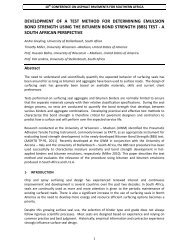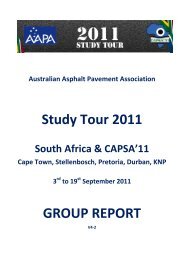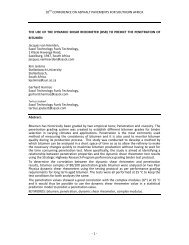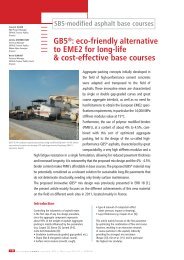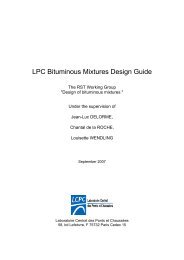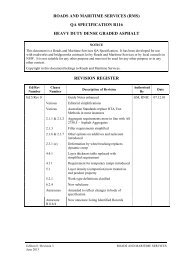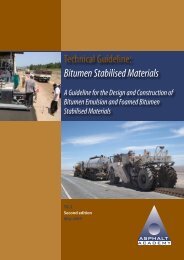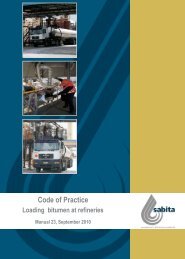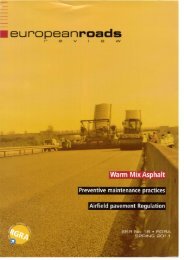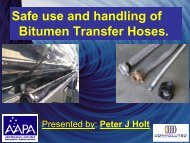Guide to the safe handling of solvents in a bituminous ... - Aapaq.org
Guide to the safe handling of solvents in a bituminous ... - Aapaq.org
Guide to the safe handling of solvents in a bituminous ... - Aapaq.org
- No tags were found...
You also want an ePaper? Increase the reach of your titles
YUMPU automatically turns print PDFs into web optimized ePapers that Google loves.
Appendix C - The management and <strong>in</strong>terpretation <strong>of</strong>MSDS (for bitum<strong>in</strong>ous products labora<strong>to</strong>ries)1. IntroductionAlways review <strong>the</strong> chemical <strong>safe</strong>ty <strong>in</strong>formation, <strong>in</strong>clud<strong>in</strong>g <strong>the</strong> MSDS beforestart<strong>in</strong>g <strong>to</strong> work with any new or unfamiliar clean<strong>in</strong>g product or chemical.MSDS provide <strong>in</strong>formation about precautions for protection aga<strong>in</strong>st knownhazards associated with <strong>the</strong> material and <strong>of</strong>ten <strong>in</strong>clude useful <strong>in</strong>formationon chemical, physical, and <strong>to</strong>xicological and ecological properties, alongwith suggestions for s<strong>to</strong>r<strong>in</strong>g, transport<strong>in</strong>g, and dispos<strong>in</strong>g <strong>of</strong> chemicals.MSDS are a general source <strong>of</strong> <strong>in</strong>formation, and <strong>the</strong>y should be consultedas a first step <strong>in</strong> assess<strong>in</strong>g <strong>the</strong> risk associated with us<strong>in</strong>g a product orchemical. However, because <strong>the</strong>re is currently no mandated <strong>in</strong>ternationalstandard format for MSDS, <strong>the</strong>ir quality varies widely depend<strong>in</strong>g uponmanufacturer, and <strong>the</strong> <strong>in</strong>formation <strong>the</strong>y conta<strong>in</strong> may be <strong>in</strong>appropriate for allapplications. It should be noted, however, that <strong>the</strong>re is a national standardfor MSDS as outl<strong>in</strong>ed <strong>in</strong> <strong>the</strong> Hazardous Chemical Substances Regulations,1995 9A, Handl<strong>in</strong>g <strong>of</strong> hazardous chemical substances.Exercise caution, and utilise non-MSDS sources <strong>of</strong> <strong>in</strong>formation, such as <strong>the</strong><strong>in</strong>ternet.(See also <strong>the</strong> list at <strong>the</strong> end <strong>of</strong> Glossary <strong>of</strong> Terms below). Neveruse a chemical product if <strong>the</strong>re is doubt about how <strong>to</strong> handle or use it. Youshould always consult with your Health, Safety and Environmental (HSE)pr<strong>of</strong>essionals if you have health, <strong>safe</strong>ty or environmental questions. Consultwith your supplier when you have application questions.2. Def<strong>in</strong>itions <strong>of</strong> typical technical terms conta<strong>in</strong>ed with<strong>in</strong> an MSDS(local and <strong>in</strong>ternational versions)action level - exposure level at which any specified exposure limit takeseffect;acute effect - <strong>in</strong>volves severe symp<strong>to</strong>ms which develop rapidly and mayquickly reach a crisis;acute exposure - a short-term exposure usually occurr<strong>in</strong>g at highconcentration;acute hazard - a s<strong>in</strong>gle exposure that may cause harm, but which isunlikely <strong>to</strong> lead <strong>to</strong> permanent damage;88



